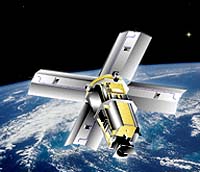| . |  |
. |
 Teasing More Power Through The Gate
Teasing More Power Through The GateAlbuquerque - March 15, 2000 - Existing satellite systems use either silicon for solar cells or a two-layered solar panel made up of the indium gallium phosphide layer and the gallium arsenide layer. Silicon space solar cells have a maximum theoretical efficiency around 23 percent, while the dual-layer indium gallium phosphide/ gallium arsenide solar cell is around 30 percent. That compares to the 40 percent efficiency rate predicted for the layered solar cell containing InGaAsN. (Each percentage figure is the maximum efficiency rate possible in perfect conditions.) The trick will be to realize these theoretical gains in practice. Commercial application becomes interesting if the addition of the InGaAsN junction can add 4 or 5 percent of overall cell efficiency compared to the best commercial devices available today. The bandgap and crystal structure (i.e., lattice constant) of InGaAsN makes it an ideal material for solar cells in space power systems. It results in reduced satellite mass and launch cost and increased payload and satellite mission. "You get two times the power from the new material as from silicon," Jones says. "With InGaAsN, the size of the solar collecting package can be smaller, meaning the satellite will weigh less, come in a smaller package, and be cheaper to launch." But before InGaAsN can realistically be used in a photovoltaic system, researchers must better understand the material, and a higher quality alloy must be developed. "We are doing a lot of tweaking to try to make the material viable," Sandia researcher Andy Allerman says. "This includes changing some things in the growth process -- like temperature -- and then measuring its effects after the InGaAsN is grown. We're trying to understand the optical and electrical properties."
Possible Laser Source Scientists in Sandia's Semiconductor Materials and Processes Department view InGaAsN as a candidate laser material that will produce the 1.3 micron bandgap needed for short-distance fiber optics systems, like those used to wire an office building. A laser produces an intense, coherent, directional beam of light from a semiconductor material that has been excited (light stimulating photons and photons stimulating more photons). The light impulse, which is encoded information then flows through fiber optic lines at the speed of light. Sandia researcher Peter Esherick says current fiber optics systems use a semiconductor alloy with a base of indium phosphide as a laser source because it can grow crystals in the right bandgap range. However, Esherick notes, "for a lot of reasons" -- including because it is cheaper -- researchers would prefer to use gallium arsenide as the base substrate. Without the addition of nitrogen, gallium arsenide's bandgap is too high to serve as a laser source. But with the nitrogen, the bandgap falls within the usable range of 0.7 to 1.4 microns. By changing the amount of nitrogen doped into the gallium arsenide, researchers can alter the laser's bandgap. Two types of semiconductor lasers exist -- edge emitter and VCSEL (vertical cavity surface emitting laser). In the edge emitter, which currently dominates the semiconductor laser market, photons shoot out one edge of the semiconductor wafer after rebounding off mirrors that have been cleaved out of the crystalline substrate. In the VCSEL laser, photons bounce vertically between mirrors grown into the structure and then shoot straight up from the wafer surface. The differences seem simple, but their potential consequences for manufacturing efficiency and new applications are tremendous. Most critically, laser devices that emit light from their upper surface can be fabricated side by side on a wafer in vast numbers. Sandia researchers have successfully built an edge emitter out of the new material, which is the first step toward incorporating the new material into a VCSEL structure.
SOLARCELL NEWS
|
| |||||||||
| The content herein, unless otherwise known to be public domain, are Copyright 1995-2016 - Space Media Network. All websites are published in Australia and are solely subject to Australian law and governed by Fair Use principals for news reporting and research purposes. AFP, UPI and IANS news wire stories are copyright Agence France-Presse, United Press International and Indo-Asia News Service. ESA news reports are copyright European Space Agency. All NASA sourced material is public domain. Additional copyrights may apply in whole or part to other bona fide parties. Advertising does not imply endorsement, agreement or approval of any opinions, statements or information provided by Space Media Network on any Web page published or hosted by Space Media Network. Privacy Statement All images and articles appearing on Space Media Network have been edited or digitally altered in some way. Any requests to remove copyright material will be acted upon in a timely and appropriate manner. Any attempt to extort money from Space Media Network will be ignored and reported to Australian Law Enforcement Agencies as a potential case of financial fraud involving the use of a telephonic carriage device or postal service. |